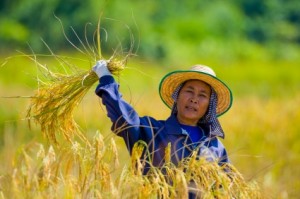In honor of International Women’s Day all of my post in the month of March will be focused on Women Rights and Women Issues.
When I dare to be powerful – to use my strength in the service of my vision, then it becomes less and less important whether I am afraid.
Audre Lorde
According to the United Nations Division for the Advancement of Women, women living in poverty are often denied access to critical resources such as credit, land and inheritance. Their labour goes unrewarded and unrecognized.
Women perform 66 percent of the world’s work, produce 50 percent of the food, but earn 10 percent of the income and own 1 percent of the property.
That is an astounding statistic. The next time you are in the grocery store buying your fresh organic vegetables, know that statistically the odds say that a woman living in poverty helped produce it. The gap between men and women caught in the cycle of poverty has continued to widen in recent years. This alarming trend is referred to as ‘the feminization of poverty’.
What Causes the Feminization of Poverty?
Ending world poverty begins with women. Research and experience have shown that women in poor countries are more likely to spend their income on food, education, and health care for their children – a long-term investment that lifts entire families and communities out of poverty. Economic opportunity for women is so important to ending the extreme poverty that cripples communities in the developing world: because when you teach a woman to fish, everybody eats.
Unfortunately unequal barriers are keeping women in developing countries from earning the income they need to provide for their families. When a mother in Kenya is not allowed to own property, for instance, she and her children will become homeless should her husband ever die. When a seamstress in the Philippines is not able to sell the clothing she makes to other countries (where people have the money to buy them), she may never be able to earn enough income to send her children to school.
UNDP Water and Development report breaks it down in startling clarity:
If the average distance to the moon is 394,400 km, South African women together walk the equivalent of a trip to the moon and back 16 times a day to supply their households with water.
Hard to stay in school, go to work and provide for your family when you are walking to the moon and back—daily. On top of all the reasons I have already mention, the current economic crisis has had a particularly hard impact on women. Women globally are concentrated in insecure jobs in the informal sector with low income and few rights; they tend to have few skills and only basic education. They are the first to be fired. Lets look at the numbers:
- Women constitute around 60–80 percent of the export manufacturing workforce in the developing world, a sector the World Bank expects to shrink significantly during the economic crisis
- The global economic crisis is expected to plunge a further 22 million women into unemployment, which would lead to a female unemployment rate of 7.4 percent (versus 7 percent of male unemployment).
- 700,000 clothing and textile workers in India lost their jobs in 2008
- More than half of the 40,000 jobs lost in the Philippines come from export processing zones, where 80 percent of workers are women
- Sri Lanka and Cambodia have each lost 30,000 mostly female garment industry jobs to date — in both countries, the garment industry accounts for at least half of export earning
- Female garment workers on abysmal wages in Bangladesh are still reeling from last year’s food crisis — and the situation can only worsen as the effects of the economic crisis kick in later this year.
 Lets be clear,this is not just “over there”– some nameless, faceless developing country. This is here in the USA as well. Women in America are more likely to be poor than men. Over half of the 37 million Americans living in poverty today are women. And women in America are further behind than women in other countries—the gap in poverty rates between men and women is wider in America than anywhere else in the Western world. Check out the link and get your mind blown…..
Lets be clear,this is not just “over there”– some nameless, faceless developing country. This is here in the USA as well. Women in America are more likely to be poor than men. Over half of the 37 million Americans living in poverty today are women. And women in America are further behind than women in other countries—the gap in poverty rates between men and women is wider in America than anywhere else in the Western world. Check out the link and get your mind blown…..
What would happen if we followed Audre Lordes’s wisdom and allowed women to be powerful and use their strength in service to their own vision and dreams and that of their communities?
I said it in a previous post and I will say it again,this year lets commit to purchasing one less “thing” and invest in one more woman. Lets commit to giving women access to financial and human capital. Once we do we will undoubtedly see family income rise. We will see children educated, health and housing will improve and communities will be transformed. Empowering women reduces poverty. Its as simple as that.

